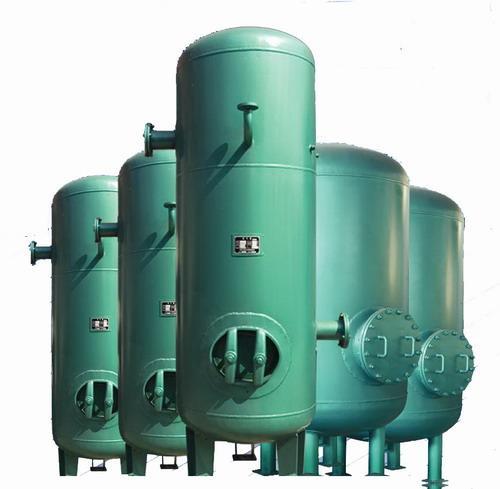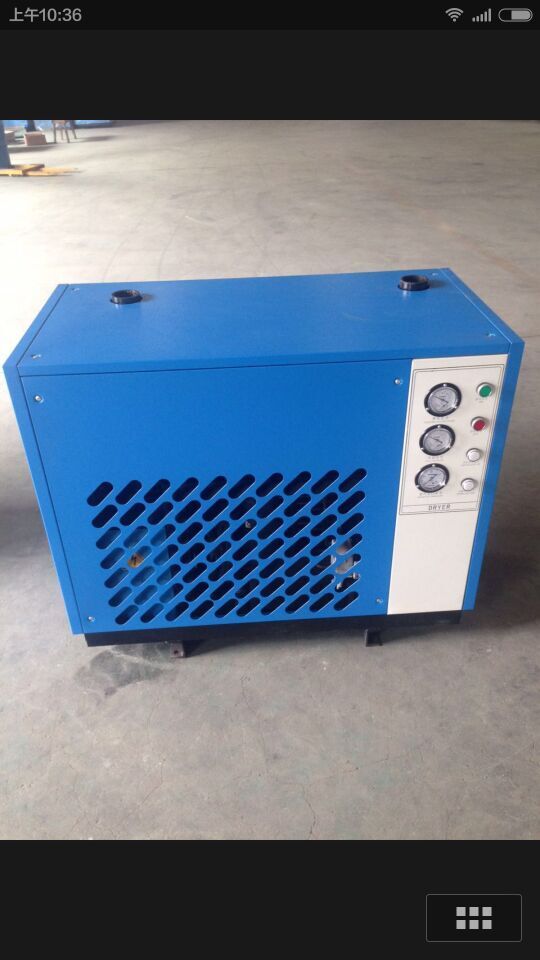What is air source equipment? What equipment is there?
The air source equipment is the generating device of compressed air – air compressor (air compressor). There are many types of air compressors, common ones are piston type, centrifugal type, screw type, sliding vane type, scroll type and so on.
The compressed air output from the air compressor contains a large amount of pollutants such as moisture, oil and dust. Purification equipment must be used to properly remove these pollutants to avoid them from causing harm to the normal operation of the pneumatic system.
Air source purification equipment is a general term for multiple equipment and devices. Air source purification equipment is also often referred to as post-processing equipment in the industry, usually referring to gas storage tanks, dryers, filters, etc.
● air tank
The function of the gas storage tank is to eliminate pressure pulsation, rely on adiabatic expansion and natural cooling to lower the temperature, further separate the moisture and oil in the compressed air, and store a certain amount of gas. On the one hand, it can alleviate the contradiction that the air consumption is greater than the output air volume of the air compressor in a short period of time. On the other hand, it can maintain a short-term air supply when the air compressor fails or the power is cut off, so as to ensure the safety of pneumatic equipment.
Compressed air dryer, as the name implies, is a kind of water removal equipment for compressed air. There are two commonly used freeze dryers and adsorption dryers, as well as deliquescent dryers and polymer membrane dryers. Refrigerated dryer is the most commonly used compressed air dehydration equipment, and it is usually used in occasions with general air source quality requirements. The refrigerated dryer uses the characteristic that the partial pressure of water vapor in the compressed air is determined by the temperature of the compressed air to perform cooling, dehydration and drying. Compressed air refrigerated dryers are generally referred to as “refrigerated dryers” in the industry. Its main function is to reduce the water content in the compressed air, that is, to reduce the “dew point temperature” of the compressed air. In the general industrial compressed air system, it is one of the necessary equipment for compressed air drying and purification (also known as post-processing).
1 basic principle
Compressed air can achieve the purpose of removing water vapor through pressurization, cooling, adsorption and other methods. Freeze dryer is the method of cooling. We know that the air compressed by the air compressor contains various gases and water vapor, so it is humid air. The moisture content of humid air is generally inversely proportional to the pressure, that is, the higher the pressure, the less the moisture content. After the air pressure is increased, the water vapor in the air beyond the possible content will condense into water (that is to say, the volume of compressed air becomes smaller and cannot hold the original water vapor).
This means that relative to the air that was originally inhaled, the moisture content becomes smaller (here refers to the return of this part of the compressed air to the uncompressed state).
However, the exhaust of the air compressor is still compressed air, and its water vapor content is at the maximum possible value, that is, it is in a critical state of gas and liquid. The compressed air at this time is called a saturated state, so as long as it is slightly pressurized, water vapor will immediately change from a gaseous state to a liquid state, that is, water will be condensed.
Assuming that the air is a wet sponge that has absorbed water, its moisture content is the absorbed water. If some water is squeezed out of the sponge by force, then the moisture content of the sponge is relatively reduced. If you let the sponge recover, it will naturally be drier than the original sponge. This also achieves the purpose of removing water and drying by pressurization.
If there is no further force after reaching a certain force during the process of squeezing the sponge, the water will stop being squeezed out, which is the saturated state. Continue to increase the strength of the squeeze, and there is still water flowing out.
Therefore, the air compressor body itself has the function of removing water, and the method used is to pressurize, but this is not the purpose of the air compressor, but a “nasty” burden.
Why is “pressurization” not used as a means of removing water from compressed air? This is mainly because of economy, increasing the pressure by 1 kg. Consuming about 7% of energy consumption is quite uneconomical.
The “cooling” dewatering is relatively economical, and the refrigerated dryer uses the same principle as the dehumidification of the air conditioner to achieve the goal. Because the density of saturated water vapor has a limit, in the aerodynamic pressure (2MPa range), it can be considered that the density of water vapor in saturated air depends only on the temperature and has nothing to do with the air pressure.
The higher the temperature, the greater the density of water vapor in the saturated air, and the more water there will be. On the contrary, the lower the temperature, the less water (this can be understood from common sense in life, winter is dry and cold, summer is hot and humid).
Cool the compressed air to a temperature as low as possible to reduce the density of the water vapor contained in it and form “condensation”, gather the small water droplets formed by the condensation and discharge them, so as to achieve the purpose of removing moisture in the compressed air .
Because it involves the process of condensation and condensing into water, the temperature cannot be lower than the “freezing point”, otherwise the phenomenon of freezing will not effectively drain water. Usually the nominal “pressure dew point temperature” of the freeze dryer is mostly 2~10°C.
For example, the “pressure dew point” at 10°C of 0.7MPa is converted into “atmospheric pressure dew point” to -16°C. It can be understood that when used in an environment not lower than -16°C, there will be no liquid water when the compressed air is exhausted to the atmosphere.
All water removal methods of compressed air are only relatively dry, meeting a certain degree of dryness. It is impossible to absolutely remove moisture, and it is very uneconomical to pursue dryness beyond the use requirements.
2 working principle
The compressed air refrigeration dryer cools the compressed air to condense the water vapor in the compressed air into liquid droplets, so as to achieve the purpose of reducing the moisture content of the compressed air.
The condensed droplets are discharged out of the machine through the automatic drainage system. As long as the ambient temperature of the downstream pipeline at the outlet of the dryer is not lower than the dew point temperature at the outlet of the evaporator, secondary condensation will not occur.
3 workflow
Compressed air process:
The compressed air enters the air heat exchanger (preheater) [1], which initially reduces the temperature of the high-temperature compressed air, and then enters the Freon/air heat exchanger (evaporator) [2], where the compressed air is cooled extremely rapidly, greatly Lower the temperature to the dew point temperature, and the separated liquid water and compressed air are separated in the water separator [3], and the separated water is discharged out of the machine by the automatic drainage device.
The compressed air and the low-temperature refrigerant exchange heat in the evaporator [2]. At this time, the temperature of the compressed air is very low, approximately equal to the dew point temperature of 2~10°C. If there is no special requirement (that is, there is no low temperature requirement for compressed air), usually the compressed air will return to the air heat exchanger (preheater) [1] to exchange heat with the high temperature compressed air that just entered the cold dryer. The purpose of doing this:
① Effectively use the “waste cooling” of dried compressed air to pre-cool the high-temperature compressed air that has just entered the cold dryer, so as to reduce the refrigeration load of the cold dryer;
② Prevent secondary problems such as condensation, dripping, and rust on the outside of the back-end pipeline caused by the dried low-temperature compressed air.
Refrigeration process:
Refrigerant freon enters the compressor [4], and after compression, the pressure increases (and the temperature also increases), and when it is slightly higher than the pressure in the condenser, the high-pressure refrigerant vapor is discharged into the condenser [6]. In the condenser, the refrigerant vapor at a higher temperature and pressure exchanges heat with air at a lower temperature (air cooling) or cooling water (water cooling), thereby condensing the refrigerant Freon into a liquid state.
At this time, the liquid refrigerant enters the Freon/air heat exchanger (evaporator) [2] through the capillary tube/expansion valve [8] to depressurize (cool down) and absorb the heat of the compressed air in the evaporator to be vaporized. The object to be cooled – the compressed air is cooled, and the vaporized refrigerant vapor is sucked away by the compressor to start the next cycle.
The refrigerant completes a cycle through four processes of compression, condensation, expansion (throttling), and evaporation in the system. Through continuous refrigeration cycles, the purpose of freezing compressed air is achieved.
4 Functions of each component
air heat exchanger
In order to prevent condensed water from forming on the outer wall of the external pipeline, the freeze-dried air leaves the evaporator and exchanges heat again with high-temperature, hot and humid compressed air in the air heat exchanger. At the same time, the temperature of the air entering the evaporator is greatly reduced.
heat exchange
The refrigerant absorbs heat and expands in the evaporator, changing from a liquid state to a gas state, and the compressed air is cooled by heat exchange, so that the water vapor in the compressed air changes from a gas state to a liquid state.
water separator
The precipitated liquid water is separated from the compressed air in the water separator. The higher the separation efficiency of the water separator, the smaller the proportion of liquid water re-volatilized into the compressed air, and the lower the pressure dew point of the compressed air.
compressor
The gaseous refrigerant enters the refrigeration compressor and is compressed to become a high-temperature, high-pressure gaseous refrigerant.
bypass valve
If the temperature of the precipitated liquid water drops below the freezing point, the condensed ice will cause ice blockage. The bypass valve can control the refrigeration temperature and control the pressure dew point at a stable temperature (between 1 and 6°C)
condenser
The condenser lowers the temperature of the refrigerant, and the refrigerant changes from a high-temperature gaseous state to a low-temperature liquid state.
filter
The filter effectively filters the impurities of the refrigerant.
Capillary/Expansion Valve
After the refrigerant passes through the capillary tube/expansion valve, its volume expands, its temperature decreases, and it becomes a low-temperature, low-pressure liquid.
Gas-liquid separator
Since the liquid refrigerant entering the compressor will cause liquid shock, which may cause damage to the refrigeration compressor, the refrigerant gas-liquid separator ensures that only gaseous refrigerant can enter the refrigeration compressor.
automatic drain
The automatic drain drains the liquid water accumulated at the bottom of the separator out of the machine at regular intervals.
dryer
The refrigerated dryer has the advantages of compact structure, convenient use and maintenance, and low maintenance costs. It is suitable for occasions where the dew point temperature of the compressed air pressure is not too low (above 0°C).
The adsorption dryer uses a desiccant to dehumidify and dry the compressed air that is forced to flow through. Regenerative adsorption dryers are often used daily.
● filter
Filters are divided into main pipeline filters, gas-water separators, activated carbon deodorization filters, steam sterilization filters, etc., and their functions are to remove oil, dust, moisture and other impurities in the air to obtain clean compressed air. Air.
Post time: May-15-2023










